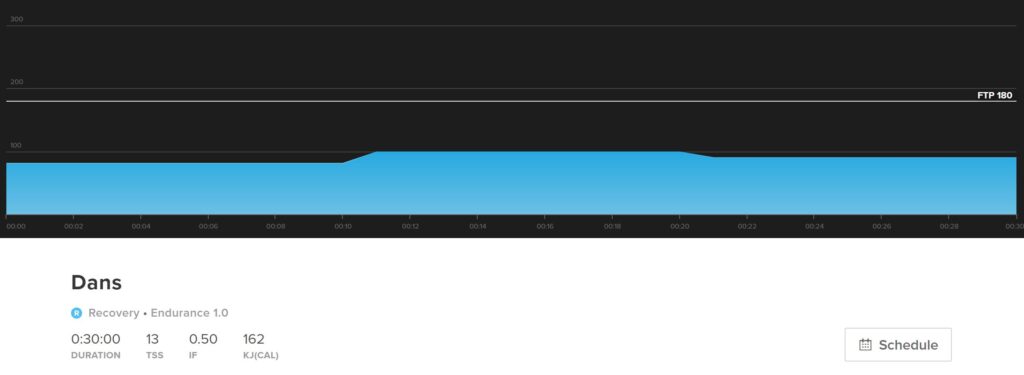Cycling Recovery Tips: Why Recovery Is Important and How to Improve It

Recovery is one of the most impactful parts of a training plan and should be prioritized by all goal-oriented cyclists. You can maximize your recovery with a dedicated recovery process, scheduled rest, and extra attention to your sleep and nutrition.
Why do you Need Recovery?
Recovery is a necessary part of any training plan—without it, you’d never actually get faster. When you recover from the stress accrued during training your body grows stronger through supercompensation. Supercompensation begins when you introduce a training stimulus that is higher than what your body is accustomed to. When your body fully recovers from this training stress, it overcompensates in preparation for these new demands. Over time this process results in an increase in abilities.
Recovery is also what makes a challenging training load manageable. In general, your system can only handle a limited amount of stress and back-to-back workouts. Incorporating rest regularly throughout your training plan helps ensure that your workouts remain productive and that you’re not at risk of overtraining.
When do you Need to Rest?
When you’re training consistently you need regular intervals of rest integrated into your training plan. On a short-term basis, you’ll want to get as much rest as possible in between your workouts with at least one day of complete rest during the week. The daily rest in between training sessions is what allows you to do several hard workouts in a row, while the weekly rest days give your body a chance to recoup from the training stress you’ve accrued during the week.
Adaptive Training
Get the right workout, every time with training that adapts to you.
Check Out TrainerRoadOutside of the regular weekly schedule, you should have a dedicated recovery week at the end of each training block. Recovery weeks give your system a complete opportunity to recover from the previous weeks in your training plan. In the long-term, you may want to consider taking a few weeks completely off the bike at the end of your season too. Rest in the off-season gives you a chance to recover from the overarching physical and mental strain of training.
Properly Periodized Training Plan
In a properly periodized training plan, the rest and recovery are already distributed into the structure of the plan. Following a plan with structured rest is a good way to ensure you’re actively incorporating recovery into your routine, and spending days off the bike. In a structured training plan, recovery time is integrated through recovery rides, recovery weeks, and rest days.
What is a Recovery Ride?
A recovery ride is an easy ride usually lasting between thirty and sixty minutes. The objective of a recovery ride is to get your blood flowing and your legs moving, all while putting minimal stress on your system. Though they can feel challenging when you’re in a fatigued state, these workouts aren’t strenuous and should promote recovery. If you’re following a structured training plan there will be recovery rides in the recovery weeks and occasionally during regular training weeks.

Rest Days
The objective of your rest days is simple—rest! On these days you shouldn’t schedule a recovery ride or even a recovery activity. Instead, you should try to put as little stress on your system as possible. In a structured training plan, you will have at least one day of dedicated rest each week, if not two or three depending on training volume. How many rest days you take each week ultimately depends on how much rest you need, which is different for every athlete.
Recovery Weeks
Recovery weeks parallel the structure of regular training weeks but have shorter workouts with little to no intensity. These workouts are usually recovery rides and are geared towards active restoration. By the end of a recovery week, you should be feeling ready to take on the next block of training. You should take a recovery week at the end of every training block—roughly every three to six weeks depending on the plan.
Rest vs. Recovery
Though the two are sometimes used interchangeably, rest and recovery differ slightly in a periodized training plan. Simply put, rest refers to downtime. When you’re resting you’re giving your body a complete break from training and other strenuous activities. Recovery encompasses the adaptation process as a whole and includes the activities and practices that assist the restoration process.
Important Aspects of Recovery for Cyclists
In addition to taking appropriate amounts of rest, you should actively attend to the important aspects of recovery during the training process. Most important are sleep and nutrition. Your sleep and your nutrition play a big role in how well you recover and can be positively influenced by a few changes.
Sleep
Much of your body’s adaptation process takes place at night when we’re in the third stage of Non-REM sleep (NREM). This stage is commonly referred to as deep sleep. During deep sleep, our bodies release hormones that promote the immune system, cellular regeneration, and tissue repair. If your sleep quality is bad, or you’re getting inadequate amounts of sleep, you risk shortchanging this recovery process.
Consistently getting eight hours of quality sleep is one of the most impactful things you can do for your recovery, which is sometimes easier said than done. If you have trouble sleeping, you might be able to improve your sleep with good sleep hygiene and a regular sleep schedule.
Recovery Nutrition
Making an effort to nourish yourself during recovery weeks, rest days, and recovery rides can help guarantee that you have enough fuel on board to aid your body’s physical adaptation process. What, when, and how much you eat will vary depending on your physiology and the level of fatigue you’re experiencing. If you come into your recovery week with excessive fatigue you might be eating more. If you are feeling a normal level of fatigue your eating habits may not change at all.
Your body is healing and adapting in response to the stress of training—it’s your job to ensure that you have enough good fuel to do so. If possible, try to avoid dieting or cutting calories during your recovery time. You need fuel to properly drive this recovery process, and if you don’t get enough in you may not be cashing in on all the hard work you’ve just completed.
Recovery Drinks
One way to help ensure that you’re getting the carbs and protein you need for recovery is to take a recovery drink immediately after training. A recovery drink isn’t absolutely necessary for recovery, but it does help guarantee that you’re getting the carbs and protein that your system needs after training. A recovery drink with a 4:1 carb-to-protein ratio has what you need to replenish your glycogen stores and fuel muscle glycogen synthesis immediately after a challenging workout.
Five Recovery Tips for Cyclists
- Prioritize Recovery: You can’t get faster without recovery. Prioritize recovery with dedicated rest days, recovery rides, and practices that enhance your time spent off the bike.
- Develop a Recovery Routine: You can enhance the recovery process with a set recovery routine. Drinking a recovery drink, foam-rolling, and yoga are a few examples of things you can incorporate into your routine.
- Nourish Yourself: Rest days, recovery rides, and recovery weeks need proper fuel. Nourishing yourself with nutrient-dense foods during the recovery process ensures that your body has the fuel that it needs to adapt and grow stronger.
- Prioritize Sleep: Improving the timing and regularity of your sleep schedule can help you feel more rested while also assisting your body’s adaptation process.
- Listen to Your Body: You know yourself better than anyone else. If you feel like you need extra time to recover, take it! You’re not going to get slower when you take the necessary time off. In fact, taking a rest when you really need it will make you faster and help you maintain your long-term motivation.